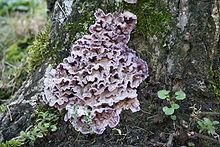- Chondrostereum purpureum
-
Chondrostereum purpureum 
Fruiting bodies of C. purpureum in a garden near Paris, France Scientific classification Kingdom: Fungi Phylum: Basidiomycota Class: Basidiomycetes Subclass: Agaricomycetidae Order: Polyporales Family: Meruliaceae Genus: Chondrostereum Species: C. purpureum Binomial name Chondrostereum purpureum
(Pers.) Pouzar (1959)Synonyms Auricularia persistens
Corticium nyssae
Phylacteria micheneri
Stereum ardoisiacum
Stereum argentinum
Stereum atrozonatum
Stereum lilacinum var. vorticosum
Stereum micheneri
Stereum nipponicum
Stereum pergameneum
Stereum purpureum
Stereum rugosiusculum
Stereum vorticosum
Terana nyssae
Thelephora purpureaSilver leaf is a fungal disease of trees caused by the fungus plant pathogen Chondrostereum purpureum. It attacks most species of the rose family Rosaceae, particularly the genus Prunus. The disease is progressive and often fatal. The common name is taken from the progressive silvering of leaves on affected branches. It is spread by airborne spores landing on freshly exposed sapwood. For this reason cherries and plums are pruned in summer, when spores are least likely to be present and when disease is visible. Silver Leaf can also happen on poming fruits like apples and pears. Plums are especially vulnerable.[1]
In the past the name Stereum purpureum Pers. was widely used for this fungus, but according to modern taxonomy it is only distantly related to Stereum, actually belonging to order Polyporales whereas Stereum is in order Russulales.[2]
Contents
Characteristics
After starting as just a crust on the wood, the fruiting structure develops undulating intergrowing brackets up to about 3 cm broad, which have a tough rubbery texture. The edges and fertile lower surfaces show a fairly vivid violet colour while the fungus is growing, and the upper surfaces have a grey aspect (sometimes with zonation) and are covered with whitish hairs. After a week or two the fructification dries out, becomes brittle, and turns a drab brown or beige.[1][3][4] Infected wood can be recognized because it is stained a darker tint.[5]
The spores are rounded cylinders approximately 5-8 µm x 3-4 µm in size. The hyphal structure is monomitic with clamp connections.
It is often found on old stumps and dead wood, but can also be a serious parasite of living trees. As well as plum trees it attacks many other broad-leafed species (other Prunus, apple, pear, willow, poplar, maple, hornbeam, plane, oak, elm, lilac, and many others).[5] Occasionally it also infects conifers (fir, spruce, Thuja, ...).[5] Geographically it is roughly speaking just as widespread as its hosts - it is common in woods, orchards and tree plantations in temperate climates.
A biological control agent
C. purpureum is commercially available as a method of combatting forest "weed" trees such as red alder, aspens and other species.[6][7] The fungus is applied directly to the weed trees in a nutrient paste which can be stored and handled conveniently. According to a report of the Canadian Pest Management Agency, the use of this control method will only have a limited impact on non-target trees since the fungal spores are ubiquitous anyway and healthy trees are resistant to attack.[8]
References
- ^ a b Entry "Silver-leaf Fungus" in Phillips, Roger (1981) "Mushrooms and other fungi of Great Britain & Europe" published by Pan Books Ltd., Cavaye Place, London SW10 9PG (ref. CN1794)
- ^ See the entry in Index Fungorum for the current name and synonyms.
- ^ Marcel Bon: The Mushrooms and Toadstools of Britain and North-Western Europe Hodder & Stoughton ISBN 0-340-39935-X.
- ^ Courtecuisse, R. & Duhem, B. (1994) "Guide des champignons de France et d'Europe" Delachaux et Niestlé ISBN 2-603-00953-2, also available in English.
- ^ a b c See Entry "Silver Leaf Disease" of Natural Resources Canada (NRCan).
- ^ U.S. patent 5587158
- ^ Canadian patent 2451038
- ^ Pesticides and Pest Management - Health Canada
- Strouts, R.G., and T. G. Winter. 2000. Diagnosis of ill-health in trees. Norwich: Stationery Office Books. ISBN 0-11-753545-1
- For instance the entry in Index Fungorum shows the current name and synonyms. In the past the name Stereum purpureum was commonly used, but according to modern taxonomy this fungus is only very distantly related to Stereum, actually belonging to order Polyporales whereas Stereum is in order Russulales.
External links
- USDA ARS Fungal Database
- Index Fungorum
- Royal Horticultural Society advice on the treatment of infected trees.
Categories: Tree diseases | Plant pathogens and diseases | Meruliaceae | Parasitic fungi | Fungi of Europe
Wikimedia Foundation. 2010.
